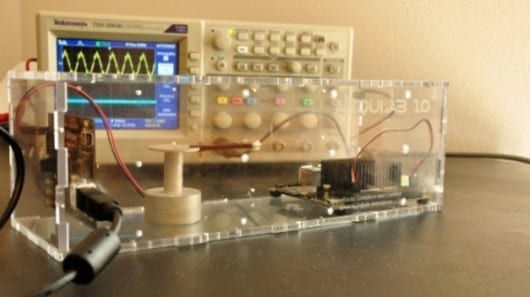
With Raspberry Pis and 3D printing all the rage, ambitious DIY projects have never been more achievable.
However, when it comes to space experiments, it’s still a professionals-only game. Start up company Infinity Aerospace out of the NASA Ames Research Center at Mountain View, California, wants to change that with Ardulab: an open source experiment package based on the Arduino processor that provides students and others with the ability to send experiments into space for under US$5,000.
The developers compare the Ardulab to the move from mainframe computers to DIY personal computers in the 1970s that put innovation in the hands of hobbyists. It’s meant to solve the problem of how to carry out microgravity experiments on a tight budget. Piggyback experiment canisters have been around since the early Space Shuttle missions, but they’ve been either very simple or required complex development, and neither were inexpensive. This is especially a barrier for students.
Ardulab was designed by a group that includes NASA’s Singularity University, Stanford’s Aerospace Engineering program, XCOR Aerospace, Atmel, Silicon Valley Space Center, and NanoRacks. Aimed at students and educators, Ardulab is an open source approach to putting experiments into space for under $5,000 and in less than 9 months.
The Ardulab package conforms to NASA standards and is intended for use on the International Space Station (ISS), though it can also be used on suborbital flights aboard Virgin Galactic, or the XCOR Lynx. It’s designed to work with experiment carriers called NanoRacks, which carry payloads that conform to the standard dimensions of a cubesat. In other words, a cube or built up in cubes that are 10 cm on a side. The NanoRack can also provide power and a data link using a USB jack.
Ardulab comes as a kit packed inside of a high-impact Pelican case for protection while shipping the finished product. Inside is a polycarbonate box that is either square or oblong, though conforming to cubesat standards. These boxes have a number of places for securing experiments and the needed hardware is also included. In addition, there is the Ardulab microcontroller based on the Arduino platform, and a USB cable. The system is described as “plug and play,” and can store up to 32 GB of data on a Micro SD card.
The Latest Bing News on:
Ardulab
- Feed has no items.
The Latest Google Headlines on:
Ardulab
[google_news title=”” keyword=”Ardulab” num_posts=”10″ blurb_length=”0″ show_thumb=”left”]
The Latest Bing News on:
Open source
- New tool pinpoints security fixes in open-source software updateson May 9, 2024 at 10:25 am
Researchers have demonstrated a new tool that analyzes open-source software updates to specify which sections of code are being modified to address recently identified security vulnerabilities. The ...
- The Raspberry Pi RP2040 Hackbat is an open source swiss army knife pen testing toolon May 9, 2024 at 5:00 am
Pablo Trujillo has created a Raspberry Pi RP2040-powered pen testing master tool known as the Hackbat and made it open source for anyone to tinker with.
- Open source Apache Pinot advances as StarTree boosts real-time analytics and observabilityon May 8, 2024 at 2:00 pm
At its annual Real-Time Analytics Summit today, StarTree announced a series of major product updates aimed at making large-scale, real-time data analytics and observability more accessible in the ...
- Open for Business: Open-Source Siliconon May 8, 2024 at 1:11 pm
A look behind OpenTitan, the world’s first commercial-grade open-source chip, and how it could change the landscape of hardware security.
- Red Hat CEO Hicks: Open Source ‘At The Center’ Of AI Innovationon May 8, 2024 at 10:35 am
Open-source technology has helped academic researchers in artificial intelligence introduce their work to the world faster and will continue to assist in bringing AI to the masses, Red Hat CEO Matt ...
- Open-Source Cybersecurity Is a Ticking Time Bombon May 8, 2024 at 8:54 am
XZ utils, an open-source compression tool embedded in myriad software products and operating systems, was found to have been implanted with a backdoor. The backdoor—a surreptitious entry point into ...
- Your Open-Source Client Options In The Non-Mastodon Fediverseon May 8, 2024 at 12:11 am
It wants to let you access other sites in the Fediverse too. A notable example is Peertube—an open-source alternative to YouTube. It’ll handle a bunch of others, too. You might think this makes ...
- RSAC: Three Strategies to Boost Open-Source Securityon May 7, 2024 at 5:00 pm
Strengthening the security of open-source software has become a significant challenge for governments, given the informal and ubiquitous nature of this community. Yet this is a crucial component of ...
- Spectral Labs Joins Hugging Face’s ESP Program to advance the Onchain x Open-Source AI Communityon May 7, 2024 at 11:30 am
Spectral also relies on Hugging Face for inferences in production through dedicated Inference Endpoints. The fully managed infrastructure allows Spectral to iterate on new models quickly, easily ...
- IBM Makes Granite AI Models Open-Source Under New InstructLab Platformon May 7, 2024 at 11:10 am
The platform announcement coincides with the open-source release of IBM's Granite models, which have historically been reserved for business use.Generative AI tools invariably rely on LLMs to operate.
The Latest Google Headlines on:
Open source
[google_news title=”” keyword=”open source” num_posts=”10″ blurb_length=”0″ show_thumb=”left”]









